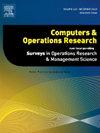灵活的作业车间重新调度使用用户首选项
IF 4.3
2区 工程技术
Q2 COMPUTER SCIENCE, INTERDISCIPLINARY APPLICATIONS
引用次数: 0
摘要
我们考虑解决柔性作业车间调度问题,新作业到达后必须通过重新调度插入生产线。新作业的插入可能会导致车间的不稳定,这可能会导致额外的成本、操作人员的疲劳、错误风险的增加和客户的不满。有几个指标被用来衡量不稳定性。这些指标可能是相互冲突的,它们的选择取决于用户。在本文中,我们进行了一个分析,考虑到DM对稳定性标准的偏好,并假设他以判断的形式表达他的偏好(例如,非常好,好,一般或坏)。我们的稳定性准则的表述允许dm解释解。DM可能接受的解决方案需要在效率标准上表现出色,同时在稳定性标准上至少达到良好的质量。我们使用称为MRSort的排序偏好模型聚合决策者对稳定性标准的偏好。我们提出了两种方法将决策偏好整合到优化过程中:一种先验方法和一种交互方法。我们表明,使用先验方法,我们能够在96%的小型实例、93%的中型实例和59%的大型实例上找到至少质量良好的解决方案,但这可能会导致效率损失。使用交互方法,我们在每种规模的大约59%的实例中获得至少良好类别的解决方案,但如果一个人的目标是获得至少良好质量的解决方案,则需要多次交互。这突出了效率与稳定之间的冲突本质。采用可变邻域搜索进行优化,并采用三种邻域结构进行局部搜索。本文章由计算机程序翻译,如有差异,请以英文原文为准。
Flexible job shop rescheduling using user preferences
We consider solving the flexible job shop scheduling problem, where new jobs arrive and must be inserted into the production line through rescheduling. The insertion of new jobs can cause instability in the workshop, which may lead to additional costs, operator fatigue, increased risk of errors, and customer dissatisfaction. Several metrics have been used to measure instability. These metrics can be conflicting, and their choice depends on the user. In this paper, we conduct an analysis considering the DM’s preferences regarding stability criteria, and assume that he expresses his preferences in the form of judgments (e.g. very good, good, average, or bad). Our formulation of stability criteria allows the DMs to interpret the solutions. The solutions potentially accepted by the DM need to excel in the efficiency criterion while achieving at least good quality on the stability criteria. We aggregate the decision-maker’s preferences on stability criteria using a sorting preference model called MRSort. We propose two approaches for integrating the DM’s preferences into the optimization process: an a priori approach and an interactive approach. We show that with the a priori approach, we are able to find solutions of at least good quality on 96% of small instances, 93% of medium instances, and 59% of large instances, but this can lead to losses in efficiency. With the interactive approach, we obtain solutions of at least good category in about 59% of instances for each size, but it requires multiple interactions if one aims to achieve solutions of at least good quality. This highlights the conflicting nature between efficiency and stability. The optimization is performed using a Variable Neighborhood Search with three types of neighborhood structures for local search.
求助全文
通过发布文献求助,成功后即可免费获取论文全文。
去求助
来源期刊

Computers & Operations Research
工程技术-工程:工业
CiteScore
8.60
自引率
8.70%
发文量
292
审稿时长
8.5 months
期刊介绍:
Operations research and computers meet in a large number of scientific fields, many of which are of vital current concern to our troubled society. These include, among others, ecology, transportation, safety, reliability, urban planning, economics, inventory control, investment strategy and logistics (including reverse logistics). Computers & Operations Research provides an international forum for the application of computers and operations research techniques to problems in these and related fields.
 求助内容:
求助内容: 应助结果提醒方式:
应助结果提醒方式:


